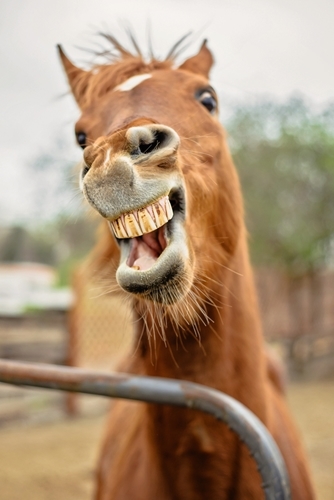Like humans, horses’ teeth make a difference in their overall health. Since teeth continue to grow throughout a horse’s lifetime, tooth problems are common, making routine dental care essential. Here’s what you need to know about their teeth to ensure equine health.
Schedule a visit for regular dental care for your horse. Young horses require more frequent dental care than older horses; while horses ages 2-5 should have a dental exam every six months, horses older than 5 should have an annual exam.
Horses that do not have regular dental checkups may experience problems chewing and grinding food as well as behavioral issues. According to the Equine Vet Services, the majority of horses have poor oral health as a result of irregular care.
Find the right dental professional
If your veterinarian doesn’t offer dental services, ask him or her to recommend someone. Typically, university veterinary schools or equine hospitals have someone on staff who does dental work.
“There are very good dentists who aren’t actually veterinarians, but it’s becoming more of a specialized field,” Adam Cayot, DVM, a veterinarian and dentist with Peterson & Smith Equine Hospital, told the Horse Channel. “State laws are changing, and some states are trying to require a veterinary license to do dentistry.”
Keep in mind, it’s the best practice to ask for certification to confirm that the dental professional has been properly trained. The International Association of Equine Dentists and the Academy of Equine Dentistry are both good sources of certification.
Also, only licensed vets are legally able to give sedatives, which are commonly used for dental work.
Floating
Your horse may encounter problems that affect its day-to-day activities. As equine lovers know, horses chew their food by grinding their teeth from side to side. Yet incomplete sideways movement can form sharp edges along the outside of the upper teeth and inside of lower teeth. As a result, their teeth may wear on one side of the upper jaw and the opposite side of the lower jaw. If left untreated, a ridge becomes quite sharp and can cut the horse’s tongue or cheeks, creating sores and ulcers.
Before this happens, a vet should “float the teeth,” a process in which any ridges or points are filed down. In the examination, veterinarians will use a metal speculum and if points are found, they’ll file the sharp edges smooth using a number of tools called floats.
Bit problems
Prior to introducing a bit to your horse, it’s crucial that teeth are in great condition. Sometimes, bits can force a portion of the cheek between sharp edges that have not yet been floated, causing lacerations in the tissue. Mouth tenderness could lead the horse to resent the bit.
So, whenever there is a bit issue, check the condition of the horse’s teeth. The most common offender is the wolf teeth, which are much smaller and sharper than the rest, and are located in front of the first molar in the back set of teeth. This area is close to where the mouth piece of a bit will lay, and when these teeth come in contact with a bit, horses may experience pain. If your horse has wolf teeth, a veterinarian can easily remove them.
Signs of teeth problems
Keep an eye out for these dental problems:
- Discomfort while eating – “quidding,” or dropping food out of the mouth
- Ulcerations on the cheek or tongue
- Resistance of the bit
- Opening the mouth or head tossing while being ridden
- Difficulty flexing at the poll
- Behavioral problems
- Poor coat and condition
- Colic
A simple oral exam is the best way to check for dental problems.








